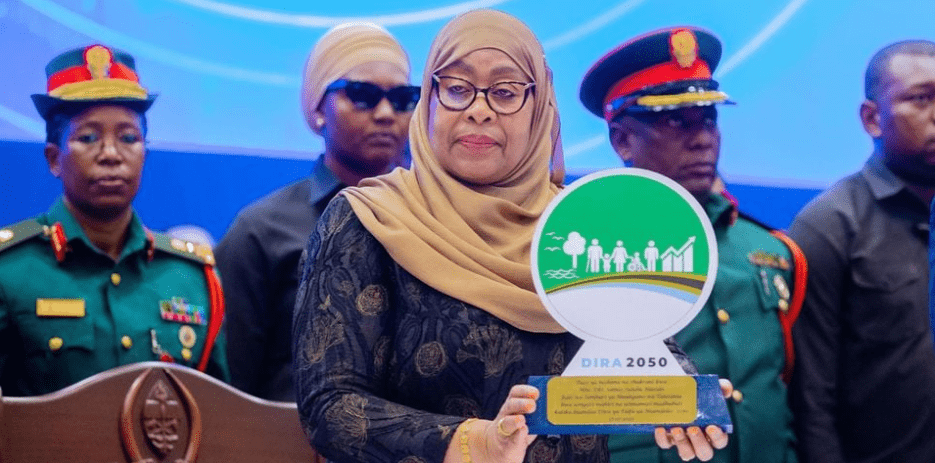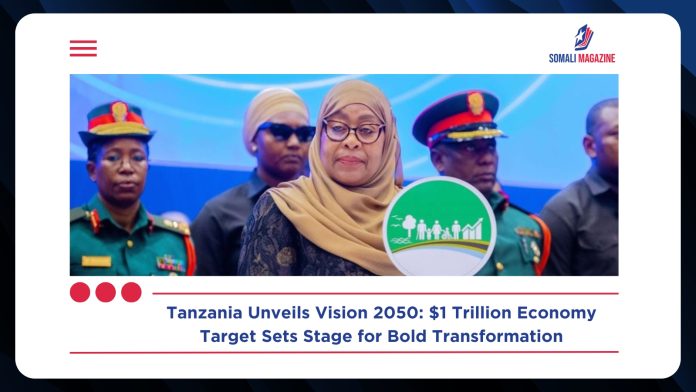Facebook Twitter (X) Instagram Somali Magazine - People's Magazine
Tanzania’s Vision 2050 targets $1trn GDP growth, unveiling an ambitious roadmap to transform the country into a high-income, industrialised economy by mid-century. Launched by President Samia Suluhu Hassan in Dodoma, the 25-year blueprint replaces Vision 2025 and sets bold targets for economic expansion, social development, and environmental sustainability.
At the heart of Vision 2050 is a commitment to elevate Tanzania’s GDP from approximately $85 billion in 2024 to $1 trillion by 2050, with a projected per capita income of $7,000. The strategy aims to eradicate extreme poverty, boost formal employment to over 50%, and position Tanzania among Africa’s top three investment destinations.
The plan identifies nine priority sectors—agriculture, tourism, industry, construction, mining, blue economy, sports and creativity, financial services, and ICT—as engines of transformation. These sectors are expected to drive value addition, job creation, and export diversification, while leveraging Tanzania’s vast natural resources and youthful population.
President Samia emphasised that the vision reflects the aspirations of Tanzanians and calls for collective action. “We thought together, wrote together, planned together—and now we must implement together,” she said. With 65% of the population under 25, the vision places strong emphasis on youth empowerment, digital literacy, and inclusive growth.
To support the transition, Vision 2050 outlines three implementation pillars: economic transformation and competitiveness, human capital development and social wellbeing, and environmental sustainability and climate resilience. These are backed by five accelerators, including integrated transport infrastructure, clean energy expansion, digital innovation, science and technology investment, and research and development.
The government aims to increase public and private investment to at least 30% of GDP, deepen financial markets, and promote public-private partnerships. Regulatory reforms will target ease of doing business, while efforts to formalise informal enterprises and empower local investors are expected to broaden economic participation.

Vision 2050 also sets social targets such as universal access to clean water, 90% electricity coverage, 70% digital literacy, and a life expectancy of 75 years. Education reforms will ensure universal secondary education and expand tertiary access, while health initiatives aim to reduce maternal and child mortality and eliminate stunting.
Environmental goals include reducing CO₂ emissions intensity, increasing forest cover, and promoting climate-smart agriculture. The vision calls for sustainable land use, water security, and disaster risk reduction to build resilience against climate shocks.
While the $1 trillion GDP target is ambitious, analysts say it is achievable with consistent double-digit growth, strategic reforms, and strong private sector engagement. Tanzania’s historical growth rate of 6.2% from 2000 to 2024 provides a solid foundation, but the country must overcome challenges such as infrastructure deficits, regulatory bottlenecks, and limited industrial productivity.
President Samia urged ministries to align policies with Vision 2050 and directed the Planning Commission to develop a long-term implementation plan ahead of the official rollout in July 2026. Legal reforms are also underway to support seamless execution and ensure accountability.
As Tanzania embarks on this transformative journey, Vision 2050 stands as a bold declaration of intent—a call to action for citizens, businesses, and development partners to build a prosperous, inclusive, and resilient future.

